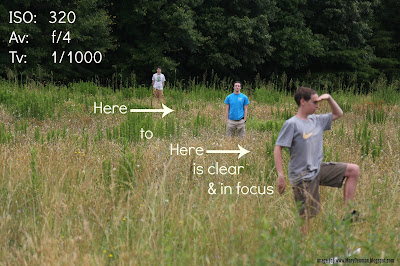
This week is Part 2 of Understanding Aperture. Last week we covered how the size of the shutter opening lets in more or less light.
A quick review:
Aperture controls the size of the shutter opening of your lens. That’s simple enough. But the challenge comes with understanding that the size of the shutter opening has two functions.
The opening of the size determines:
1) how much light can be let in.
2) how deep the depth of field is.
Today, I'm going to show you how aperture controls depth of field and about the power to use aperture to create clear or blurred backgrounds.
Let's get started:
1) How much light is let in. The smaller shutter opening (f/32) lets in the least amount of light while the largest opening (f/1.4) lets in the most light.
2) How much depth of field there is. With f/32, you get the most in focus in your picture. F/1.4 has the narrowest depth of field and only a sliver of the photo will be in focus.
 |
| COLLAGE 1: Chart showing aperture function of lens |
(NOTE: Not all lens have f-stops of 32, f/2.8, f/2, or f/1.4. The most typical f-stops are f/22 through f/4, depending on the size of the lens.)
Let's get to some examples to illustrate depth of field.
COLLAGE 2: Here's a series of roses taken at the same ISO. What I did change was the aperture which also affected how long the shutter was open.
 |
| COLLAGE 2: Shots showing how aperture affects background clarity or blurring by Mary Denman |
In the first shot, the aperture was set on f/22. This meant that it let in the least amount of light but also had the largest depth of field. While the background is not perfectly clear (due to the distance away from the subject), it is still distinguishable and cluttered which prevents the total focus from being on the rose.
As the aperture changes, from f/16 to f/8 to f/4, notice that the background is less in focus.
An aperture of f/4 has the most narrow depth of field. Now the rose is in focus and none of the background is. This showcases the rose.
TIP 1: Use a narrow depth of field, like an aperture of f/4, to isolate your subject and blur the background the most. This is very effective for taking individual subjects such as people, flowers, or objects that you want to set off.
 |
| PHOTO 1: Use a narrow depth of field anywhere in your shot |
In PHOTOS 1 & 2, I used an aperture of f/4 and made the focal point my son in blue. Because of the narrow depth of field, my other two sons are blurry and out of focus.
 |
| PHOTO 2: Use a narrow depth of field anywhere in your shot |
TIP 2: You can choose where the camera focuses and thereby control what part of the photo is in focus. You can also control HOW MUCH of the photo is in focus by changing your aperture.
We see that using f/4 is helpful for isolating your subject, so when is it helpful to use f/22? This leads us to tip 3.
TIP 3: Use an aperture value of f/22 when you want most of your photo in focus. This is good for landscapes, large buildings or a large area. You can see this illustrated in COLLAGE 3.
 |
| COLLAGE 3: Use f/22 to get most of the photo in focus |
So now that we've covered what aperture does, I want you to grab your camera and try playing around. Remember, you can use either the Aperture (A) mode or Manual (M) mode on your camera.
You can read about Understanding Aperture, Part 1 here for more details.
My boys leaving their assignment of helping me illustrate aperture....f/22
When you start getting more comfortable with your camera, you can take better and better pictures and use them for your blog. I enjoy using my photography to illustrate points.
But this week's photography tips also apply figuratively to blogging. Every time we blog, we need to know what our focus is. Do we need an f-stop of 22 and try to make the bigger picture clear? Or is the point of our post very focused? We might need an f-stop of 4 so that we hone in on one very important thing.
It does matter. I sometimes start writing a post at f/22 and realize I need to stop and focus in on the real heart of the matter. Other times, I need to look at the big picture more clearly. Realize too that the f-stop changes from picture to picture and post to post. Mix it up!
 |
| Irony.....f/4 |
For CELL PHONE USERS: Cell phones don't generally come with aperture control. However, you can control where you focus in your shots very easily. In the case of my three sons above, if I had used my cell to take the same shots, all I would have done differently is tap on the screen on the particular son I wanted to focus on. That simple tap tells the camera where to focus. Play around with your phone and see what it can do!
TWEETABLE: Understanding Aperture Part 2, Depth of Field (click and tweet!)
So, go grab your cell or camera and try this out!
Hope these tips help!
Keep on clicking!
Mary
TWEETABLE: Understanding Aperture Part 2, Depth of Field (click and tweet!)














Awesome. Thanks for the photo tips. PINNED. Linda at Crafts a la Mode
ReplyDeleteI'd love to have you link to our party also: http://www.craftsalamode.com/2015/06/what-to-do-weekends-125.html
hank you Mary for these tips, I learn something new each time I visit!
ReplyDeleteThanks for sharing this week on Friday Features!!
Hope you enjoy your weekend!
Karren
Happy Weekend Mary!! Thanks for linking up with me this weekend...I appreciate it!!
ReplyDeleteYou make it so easy, Mary.
ReplyDeleteI still have to practice on last week's blog. I'm pinning it because I have to improve.
Thanks for sharing so many great tips!
I'm giggling at "irony.... f/4."
ReplyDelete